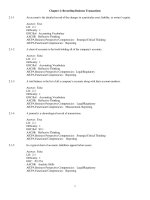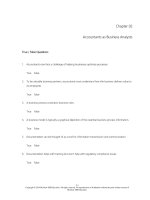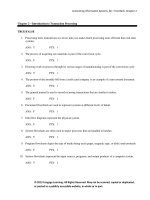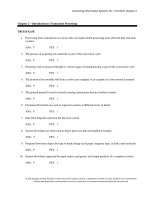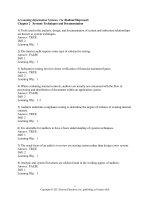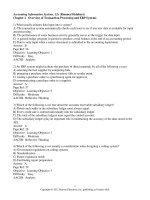Accounting information systems 9th edition gelinas test bank
Bạn đang xem bản rút gọn của tài liệu. Xem và tải ngay bản đầy đủ của tài liệu tại đây (109.16 KB, 43 trang )
Chapter 2--Enterprise Systems
Student: ___________________________________________________________________________
1. One of the primary goals of implementing an ERP system is to standardize systems across multiple locations
and multiple divisions.
True False
2. Large multilocation and multidivision companies are challenged to see the greatest benefits from ERP
systems.
True False
3. Early adopters of ERP systems were in the business of making products.
True False
4. ERP systems have proved to be quite easy to install and in short periods of time.
True False
5. Enterprise systems potentially integrate the business process functionality and information from all of an
organization's functional areas.
True False
6. With an enterprise system an organization will conduct business in a more costly manner.
True False
7. An add-on software module in an enterprise system might be a customer relationship management system
(CRM).
True False
8. The dominant player in the large system ERP arena is Microsoft.
True False
9. SAP has a primary focus on large Fortune 500 type companies.
True False
10. Microsoft Dynamics and Sage Group focus on small and mid market sized companies.
True False
11. Customer relationship management (CRM) software builds and maintains an organization's
customer-related database.
True False
12. Customer relationship management (CRM) software aggregates, manages, and retains data across the entire
organization for the identification, acquisition, and retention of vendors to maximize the benefits of those
relationships.
True False
13. If you have made a Web purchase such as with Amazon.com you have experienced some of the
functionality of a CRM system where the vendor keeps track of your name, address, and purchases.
True False
14. Customer relationship management (CRM) functionality includes procurement and contract management.
True False
15. Customer self service (CSS) software is often an extension of CRM software.
True False
16. Supply chain management (SCM) software helps plan and execute steps such as demand planning,
acquiring inventory, manufacturing, distributing, and selling the product.
True False
17. Supplier relationship management (SRM) software manages the interactions with the organization's that
supply the goods and services to an enterprise.
True False
18. Middleware is a software product that connects two or more separate applications or software modules.
True False
19. Enterpriseware might be used to stitch together a number of legacy systems, an enterprise system,
best-of-breed applications, and Web-based applications.
True False
20. An Application Programming Interface (API) is a means for connecting to a system or application provided
by the developer of that application.
True False
21. Microsoft Dynamics Snap line of tools is an example of an Application Programming Interface.
True False
22. Enterprise application integration (EAI) links together two or more systems and allows them to work
together.
True False
23. Product life-cycle management (PLM) software manages product data from design through manufacture,
and disposal.
True False
24. Enterprise Services Bus (ESB) is a type of communications-broker software that uses standardized protocols
to let event-driven applications communicate in a less-expensive manner than can the tightly-coupled,
synchronous enterprise application integration (EAI) platforms.
True False
25. DreamWeaver is a Web services platform from SAP that can be used to build applications that integrate
business processes and databases from a number of sources within and between organizations.
True False
26. Business process management (BPM) provides a comprehensive method for integrating manual and
automated internal processes, applications, and systems, as well as integration to external partners and services.
True False
27. With a best-of-breed approach an organization can minimize the number of different software modules
employed to implement an enterprise system.
True False
28. Event driven-architecture (EDA) is an approach to designing and building enterprise systems in which
business events trigger messages to be sent by middleware between independent software modules that are
completely unaware of each other.
True False
29. In event driven architecture (EDA) the business unit "pushes" the event to the recipient rather than waiting
for the recipient to request or "pull", the event.
True False
30. The value chain is a chain of activities performed by the organization to transform outputs into inputs
valued by the customer.
True False
31. An organization creates a competitive advantage by creating less value for its customers than does its
competition.
True False
32. Supporting activities of the value chain include activities directly involved with marketing, producing,
selling, and delivering the product or service to the customer.
True False
33. Primary activities of the value chain provide infrastructure such as procurement, information technology,
human resources, and accounting.
True False
34. The value chain works to separate the functional activities or silos of the organization.
True False
35. Dell's value chain takes raw materials, manufactures computers and other products, and delivers them to
customers in a timely manner at an attractive price.
True False
36. The activities in the value chain, the value activities, are business processes that convert inputs to valued
outputs.
True False
37. In a disaggregated information system, the customer will be notified immediately whether the item is on the
shelf and not committed to another customer.
True False
38. Telling the customer when they will receive an item is known as available to promise (ATP).
True False
39. A character is a basic unit of data such as a letter, number, or special character.
True False
40. A field is a collection of related characters that comprise an attribute, such as a customer number or name.
True False
41. A record is a collection of related data fields pertaining to a particular entity or event.
True False
42. The credit limit within a customer record always provides unlimited authorization to accept a customer
order.
True False
43. Segregation of duties includes separating the sales and credit departments.
True False
44. Generally, when processing a customer order, one does not need to know the total price of the goods before
credit authorization can be made.
True False
45. In an enterprise system, once a customer order is completed, the purchasing function can be immediately
informed that the merchandise has been sold and may need to be replenished.
True False
46. It is best to combine authorization of data-maintenance activities with authorization of business event
processing activities.
True False
47. An enterprise systems centralized database can make data, such as inventory data, visible throughout the
organization.
True False
48. The correct sequence of the three steps in the sales and distribution process are (1) order entry (2) shipment
process and (3) billing process.
True False
49. The correct sequence of the three steps in the materials management process is (1) record vendor invoice (2)
create purchase order (3) receive the goods.
True False
50. The bottom line is that without integrated information systems organizations have difficulty being managed
on a day-to-day basis and being successful in the long run.
True False
51. The financial accounting module integrates with the sales and distribution and materials management
modules.
True False
52. The purchase-to-pay process includes the events surrounding the sale of goods to a customer, the
recognition of revenue, and the collection of the customer payment.
True False
53. The order-to-cash process includes events surrounding the purchase of goods from a vendor, the recognition
of those costs, and the payment to the vendor.
True False
54. With the installation of an enterprise system an organization should experience all of the following except
A. improved customer service
B. empowerment of decentralized operations
C. improved budgeting
D. reduced personnel
55. Core applications of an ERP are
A. financial accounting
B. materials management
C. sales and distribution
D. all of the above
56. Which of the following is usually not part of an ERP's core applications?
A. legacy systems
B. financial accounting
C. material management
D. sales and distribution
57. The enterprise system might facilitate the purchase of office equipment by all of the following except
A. providing an electronic order form (a purchase requisition)
B. assisting the vendor with the selection of the appropriate purchase order
C. routing the order to appropriate authorities for specific approval
D. making data available for management analysis
58. The most dominant player in the ERP market for large companies is
A. Oracle
B. Sage
C. SAP
D. Microsoft
59. Which statement about ERP installation is least accurate?
A. For the ERP to be successful, process reengineering is normally required.
B. A problem with ERPs is that some important business processes may not be supported.
C. When a business is diversified, little is gained from ERP installation.
D. Only required modules need be installed.
60. Which statement is true?
A. ERPs are infinitely scalable.
B. Performance problems usually stem from technical problems, not business process reengineering.
C. The better ERP can handle any problems an organization can have.
D. ERP systems can be modified using add-on software.
61. Software that builds and maintains an organization's customer-related database is known as
A. customer relationship management (CRM) software
B. customer self service (CSS) software
C. sales force automation (SFA) software
D. supply chain management (SCM) software
62. Software that allows an organization's customers to complete inquiry without the aid of the organization's
employees is known as
A. customer relationship management (CRM) software
B. customer self service (CSS) software
C. sales force automation (SFA) software
D. supply chain management (SCM) software
63. Software that automates sales tasks such as order processing and tracking is known as
A. customer relationship management (CRM) software
B. customer self service (CSS) software
C. sales force automation (SFA) software
D. supply chain management (SCM) software
64. Software that helps execute steps such as demand planning, acquiring inventory, manufacturing,
distribution, and sales is known as
A. customer relationship management (CRM) software
B. customer self service (CSS) software
C. supplier relationship management (SRM) software
D. supply chain management (SCM) software
65. Software that manages the interactions with the organization's that supply the goods and services to an
enterprise is known as
A. customer relationship management (CRM) software
B. customer self service (CSS) software
C. supplier relationship management (SRM) software
D. supply chain management (SCM) software
66. Software that manages the product, beginning with the design of the product, continuing through
manufacture and culminating in the disposal of the product, is known as
A. product lifecycle management (PLM) software
B. product relationship management (PRM) software
C. product self service (PSS) software
D. supplier relationship management (SRM) software
67. Supply chain management (SCM) software
A. is typically under the control of external partners in the chain.
B. helps plan and execute demand planning; acquiring inventory; and manufacturing, distributing, and selling a
product.
C. cannot be integrated into an overall ERP.
D. none of the above
68. Some third-party modules can extract data from
A. legacy systems only
B. ERP systems only
C. both legacy systems and ERP systems
D. all of the above
69. Which of the following tracks a product from design, continuing through manufacture, and culminating with
the disposal of the product at the end of its life?
A. supply chain management (SCM)
B. value chain
C. product life cycle management (PLM)
D. none of the above
70. Technology that can connect together ERP systems and third party add-on modules is called
A. supply chain software
B. enterprise application integration (EAI)
C. EDP systems
D. none of the above
71. Enterprise systems support an organization by:
A. facilitating the functioning of an organization's operations
B. retaining records about business events
C. storing data useful for decision making
D. all of the above
72. In an event-driven architecture (EDA)
A. business events are handled as batches of events
B. a business unit "pulls" the event to the recipient
C. business events are "pushed" immediately and simultaneously to all interested parties
D. none of the above
73. In an event-driven architecture (EDA)
A. business events are processed in batches
B. the enterprise operates in real time
C. the enterprise only uses modules from a single software vendor
D. none of the above
74. In an event-driven architecture (EDA)
A. each business event is handled individually
B. real time processing reduces delays in business processing
C. an event notification is sent to the middleware, also known as "publish" or "send"
D. all of the above
75. The general term for software that connects third-party modules to ERP systems is known as
A. DreamWeaver
B. Middleware
C. Microsoft
D. NetWeaver
76. An approach to designing and building enterprise systems in which business events trigger messages to be
sent by middleware between independent software modules that are completely unaware of each other.
A. Application Programming Interface (API)
B. Business Process Management (BPM)
C. Enterprise Resource Planning (ERP)
D. Event-driven architecture (EDA)
77. This provides a comprehensive method for integrating manual and automated internal processes,
applications, and systems, as well as integration to external partners and services.
A. Application Programming Interface (API)
B. Business Process Management (BPM)
C. Enterprise Resource Planning (ERP)
D. Event-driven architecture (EDA)
78. Primary activities of the value chain include
A. Accounting
B. human resources
C. Procurement
D. Production
79. Supporting activities of the value chain include
A. Accounting
B. Marketing
C. Production
D. Sales
80. Information technology (IT) has been able to create additional value by
A. reducing costs
B. improving quality
C. balancing the cost and timeliness of value activities
D. all of the above
81. Which of the following statements is false?
A. Value chain activities need to be closely coordinated.
B. Primary value chain activities include marketing and sales.
C. An organization's value chain is the only component of the value system.
D. None of the statements are false.
82. The correct sequence of elements leading to an "available to promise" (ATP) is
A. item is not committed to another customer, item is on shelf, determine pricing, check customer credit limit
B. item is on shelf, determine pricing, item is not committed to another customer, check customer credit limit
C. item is on shelf, item is not committed to another customer, check customer credit limit, determine pricing
D. item is on shelf, item is not committed to another customer, determine pricing, check customer credit limit
83. The four Ws of capturing data do not include
A. Who
B. What
C. Why
D. When
84. A basic unit of data such as a letter, number, or special character is known as a
A. Character
B. Field
C. Record
D. none of the above
85. A collection of related characters that comprise an attribute such as a customer number or name is known as
a
A. Character
B. Field
C. Record
D. none of the above
86. A collection of related data fields pertaining to a particular entity or event is known as a
A. Character
B. Field
C. Record
D. none of the above
87. The correct sequence of events for entering a customer order is
A. edit order, record sales order, update inventory, notify warehouse
B. record sales order, edit order, update inventory, notify warehouse
C. notify warehouse, edit order, record sales order, update inventory
D. edit order, notify warehouse, record sales order, update inventory
88. Steps in the sales and distribution process include all of the following except
A. order entry
B. shipment
C. receiving
D. billing
89. Steps in the materials management process include all of the following except
A. creating the purchase order
B. shipment
C. receiving
D. recording the vendor invoice
90. The ____ module plays a central role in the SAP system by collecting business events from other modules.
A. human resources
B. controlling and profitability analysis
C. financial accounting
D. customer relationship management
91. The ____ module of the SAP system handles internal accounting including cost center accounting,
activity-based accounting, and budgeting.
A. human resources
B. controlling and profitability analysis
C. financial accounting
D. customer relationship management
92. The ____ module of the SAP system handles payroll processing.
A. human resources
B. controlling and profitability analysis
C. financial accounting
D. customer relationship management
93. Which of the following is included in the first step in the order-to-cash process?
A. sales order processing
B. responding to customer inquiries
C. pick and pack
D. billing
94. What is the correct sequence of the order-to-cash process?
A. sales order processing; pick and pack; shipping; billing; payment; responding to customer inquiries
B. sales order processing; responding to customer inquiries; pick and pack; shipping; billing; payment
C. sales order processing; pick and pack; billing; shipping; payment; responding to customer inquiries
D. responding to customer inquiries; sales order processing; pick and pack; shipping; billing; payment
95. What is the first step in the purchase-to-pay process?
A. purchase order processing
B. pick and pack
C. requirements determination
D. goods receipt
96. What is the correct sequence of the purchase-to-pay process?
A. purchase order processing; goods receipt; invoice verification; payment processing; requirements
determination
B. requirements determination; purchase order processing; goods receipt; invoice verification; payment
processing
C. purchase order processing; requirements determination; goods receipt; invoice verification; payment
processing
D. purchase order processing; requirements determination; invoice verification goods receipt; payment
processing
97. ______________________________ integrate the business process functionality and information from all
of an organization's functional areas, such as marketing and sales, cash receipts, purchasing, cash
disbursements, human resources, production and logistics, and business reporting (including financial
reporting).
________________________________________
98. ______________________________ are software packages that can be used for the core systems necessary
to support enterprise systems.
________________________________________
99. ______________________________ software builds and maintains an organization's customer-related
database.
________________________________________
100. ______________________________ software allows an organization's customers to complete an inquiry,
perform a task (including sales), or troubleshoot problems, without the aid of an organization's employees.
________________________________________
101. ______________________________ software automates sales tasks such as order processing, contact
management, inventory monitoring, order tracking, and employee performance evaluation.
________________________________________
102. ______________________________ software helps plan and execute the steps in an organization's supply
chain including demand planning; acquiring inventory; and manufacturing, distributing, and selling the
product.
________________________________________
103. ______________________________ software manages the interactions with the organizations that supply
the goods and services to an enterprise.
________________________________________
104. ______________________________ software manages product data during a product's life, beginning
with the design of the product, continuing through manufacture, and culminating in the disposal of the product
at the end of its life.
________________________________________
105. ______________________________ is the dominant player in the ERP market for large businesses.
________________________________________
106. ______________________________ includes integration of business processes, software, standards, and
hardware to link two or more systems together allowing them to act as one.
________________________________________
107. The ______________________________ approach combines modules from various vendors to create an
information system that better meets an organization's needs than a standard ERP system.
________________________________________
108. A(n) ______________________________ is a means for connecting to a system or application provided
by the developer of that application.
________________________________________
109. ______________________________ usually includes a design environment for modeling and
documenting business processes. This is often integrated with the process engine to support iterative design and
implementation efforts for maximum process agility
________________________________________
110. ______________________________ is an approach to designing and building enterprise systems in which
business events trigger messages to be sent by middleware between independent software modules that are
completely unaware of each other.
________________________________________
111. ______________________________ is communications-broker software that uses standardized protocols
to let event-driven applications communicate in a less expensive manner than can the tightly coupled,
synchronous EAI platforms.
________________________________________
112. Primary activities of the ______________________________ include activities directly involved with
marketing, producing, selling, and delivering the product or service to the customer.
________________________________________
113. The ______________________________ of the value chain include functions such as moving raw
materials into and around the organization, producing and delivering goods to the customer, and performing
services such as installation and after-sales support.
________________________________________
114. The ______________________________ of the value chain are those that provide infrastructure and
include functions such as procurement, information technology, human resources and accounting.
________________________________________
115. Telling the customer when the item will be received is known as ______________________________.
________________________________________
116. A(n) ______________________________ is a basic unit of data such as a letter, number, or special
character.
________________________________________
117. A(n) ______________________________ is a collection of related characters that comprise an attribute,
such as a customer number or name.
________________________________________
118. A(n) ______________________________ is a collection of related data fields pertaining to a particular
entity or event.
________________________________________
119. The existence of the customer record, including the ______________________________, provides the
basic authorization required to accept and record the customer order.
________________________________________
120. The ______________________________ process includes the events surrounding the sale of goods to a
customer, the recognition of revenue, and the collection of the customer payment.
________________________________________
121. The ______________________________ process includes events surrounding the purchase of goods from
a vendor, the recognition of the cost of those goods, and the payment to the vendor
________________________________________
122. ______________________________ are older systems that may exist in an organization when a newer
system, such as an ERP, is installed.
________________________________________
123. Business events are "pushed" immediately and simultaneously to all interested parties in
______________________________ architecture.
________________________________________
124. The four Ws of capturing data are ______________________________,
______________________________, ______________________________, and
______________________________.
________________________________________
125. Edit order, record sales order, update inventory, notify warehouse is the sequence of events for entering
a(n) ______________________________.
________________________________________
126. The steps in the ______________________________ process include creating the purchase order,
receiving the goods and services, recording the vendor invoice
________________________________________
127. The module that handles internal accounting including cost center accounting, activity based accounting,
and budgeting is ______________________________.
________________________________________
128. The module that handles payroll processing is ______________________________.
________________________________________
129. The first step in the order-to-cash process is ______________________________.
________________________________________
130. The first step in the purchase-to-pay process is ______________________________.
________________________________________
131. ______________________________ include any meaningful change in the state of an enterprise, such as
creating a new employee record, submitting a purchase order to a vendor, receiving a payment from a customer,
picking goods from a warehouse and delivering them to the shipping department, and revaluing inventory.
________________________________________
132. Third-party modules are connected to the ERP system using ______________________________, a
software product that connects two or more separate applications or software modules.
________________________________________
133. Define enterprise resource planning (ERP) systems and give some examples of common ERP add-on
modules.
134. What are the primary activities of the value chain and what are some of the main functions included in the
value chain?
135. List and describe the 6 steps in the order-to-cash process.
136. List and describe the 5 steps in the purchase-to-pay process.
137. Describe 5 of the pros of an enterprise system.
138. Describe 3 of the cons of an enterprise system.
139. Why might a firm decide to implement only certain modules in an ERP system rather than a complete
implementation?
140. Why must an organization expect the implementation of an ERP to disrupt operations?
141. Describe and explain these concepts and their relationship to one another: enterprise application
integration, middleware, application programming interface, event-driven architecture, enterprise services bus.
Chapter 2--Enterprise Systems Key
1. One of the primary goals of implementing an ERP system is to standardize systems across multiple locations
and multiple divisions.
TRUE
2. Large multilocation and multidivision companies are challenged to see the greatest benefits from ERP
systems.
FALSE
3. Early adopters of ERP systems were in the business of making products.
TRUE
4. ERP systems have proved to be quite easy to install and in short periods of time.
FALSE
5. Enterprise systems potentially integrate the business process functionality and information from all of an
organization's functional areas.
TRUE
6. With an enterprise system an organization will conduct business in a more costly manner.
FALSE
7. An add-on software module in an enterprise system might be a customer relationship management system
(CRM).
TRUE
8. The dominant player in the large system ERP arena is Microsoft.
FALSE
9. SAP has a primary focus on large Fortune 500 type companies.
TRUE
10. Microsoft Dynamics and Sage Group focus on small and mid market sized companies.
TRUE
11. Customer relationship management (CRM) software builds and maintains an organization's
customer-related database.
TRUE
12. Customer relationship management (CRM) software aggregates, manages, and retains data across the entire
organization for the identification, acquisition, and retention of vendors to maximize the benefits of those
relationships.
FALSE
13. If you have made a Web purchase such as with Amazon.com you have experienced some of the
functionality of a CRM system where the vendor keeps track of your name, address, and purchases.
TRUE
14. Customer relationship management (CRM) functionality includes procurement and contract management.
FALSE
15. Customer self service (CSS) software is often an extension of CRM software.
TRUE
16. Supply chain management (SCM) software helps plan and execute steps such as demand planning,
acquiring inventory, manufacturing, distributing, and selling the product.
TRUE
17. Supplier relationship management (SRM) software manages the interactions with the organization's that
supply the goods and services to an enterprise.
TRUE
18. Middleware is a software product that connects two or more separate applications or software modules.
TRUE
19. Enterpriseware might be used to stitch together a number of legacy systems, an enterprise system,
best-of-breed applications, and Web-based applications.
FALSE
20. An Application Programming Interface (API) is a means for connecting to a system or application provided
by the developer of that application.
TRUE
21. Microsoft Dynamics Snap line of tools is an example of an Application Programming Interface.
TRUE
22. Enterprise application integration (EAI) links together two or more systems and allows them to work
together.
TRUE
23. Product life-cycle management (PLM) software manages product data from design through manufacture,
and disposal.
TRUE
24. Enterprise Services Bus (ESB) is a type of communications-broker software that uses standardized protocols
to let event-driven applications communicate in a less-expensive manner than can the tightly-coupled,
synchronous enterprise application integration (EAI) platforms.
TRUE
25. DreamWeaver is a Web services platform from SAP that can be used to build applications that integrate
business processes and databases from a number of sources within and between organizations.
FALSE
26. Business process management (BPM) provides a comprehensive method for integrating manual and
automated internal processes, applications, and systems, as well as integration to external partners and services.
TRUE
27. With a best-of-breed approach an organization can minimize the number of different software modules
employed to implement an enterprise system.
FALSE
28. Event driven-architecture (EDA) is an approach to designing and building enterprise systems in which
business events trigger messages to be sent by middleware between independent software modules that are
completely unaware of each other.
TRUE
29. In event driven architecture (EDA) the business unit "pushes" the event to the recipient rather than waiting
for the recipient to request or "pull", the event.
TRUE
30. The value chain is a chain of activities performed by the organization to transform outputs into inputs
valued by the customer.
FALSE
31. An organization creates a competitive advantage by creating less value for its customers than does its
competition.
FALSE
32. Supporting activities of the value chain include activities directly involved with marketing, producing,
selling, and delivering the product or service to the customer.
FALSE
33. Primary activities of the value chain provide infrastructure such as procurement, information technology,
human resources, and accounting.
FALSE


